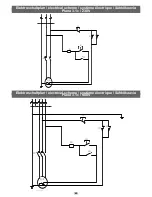
of dangers, in compliance with the operating
instructions! Failures which can affect safety
in particular must be removed straight away!
• The manufacturer’s stipulations concerning
safety, work and maintenance as well as the
measurements specified in Technical data,
must be complied with.
• The relevant accident prevention stipulations
and other widely recognised safety rules
must be observed.
• The machine may be used, maintained or
repaired only by expert personnel who are
familiar with it and its dangers. Unautho-
rised changes to the machine invalidate the
manufacturer’s liability for damages resulting
from this.
• The machine may be used only with the
manufacturer’s original accessories and
original tools.
• Every use beyond that is deemed as not
intended. The manufacturer is not liable
for damage resulting from this, the risk lies
exclusively with the user.
Residual risks
m
• the machine has been built according to
the latest technology and recognised safety
rules. However, individual residual risks can
occur when working: Risk of injury to fingers
and hands from the rotating cutterblock
during incorrect handling of the work piece.
Never reach with your hands under the
cutter block guard when guiding the work
piece! Do not pull the work piece back over
the unguarded cutter block.
• Injuries when the work piece is ejected
during incorrect mounting or handling, such
as working without a fence.
• Health risk from wood dust and shavings.
• Make sure you wear personal protective
equipment such as eye protection and a
dust mask. Use an extraction unit!
• Health risk from noise during work, the per-
mitted noise level is exceeded. Make sure
you wear personal protective equipment
such as hearing protection.
• Electrical hazards when unsuitable electric
connections are used
• Process chosen wood only, without imper-
fections such as: Knots, transverse cracks,
surface cracks, foreign objects (nails,
screws). Flawed wood creates a risk during
work.
• Furthermore, despite all measures taken,
residual risks can occur that are not obvi-
ous.
• Residual risks can be minimised by comply-
ing with the safety notices and the intended
use as well as the operating instructions
overal
• Drawing-in/trapping hazard by power feed
mechanism.
• Squeezing hazard by work piece power-
outfeed.
Set-up
Prepare the work place where the power tool
will be used. Make sufficient space so that
safe and uninterrupted work is ensured. The
power tool has been designed for work in
closed rooms, and it has to be set up on an
even, level, solid surface in a stable position.
Fixing the machine on level hard concrete
floor before operation.
Equipment fig. 1
1 Jointer table fixed
2 Jointer table adjustable
3 Jointing fence
4 Cutterblock cover
5 Table adjustment lever
6 Locking handle for thicknessing table
7 Infeed locking lever
8 Extraction hood
9 Table locking system
10 Thicknessing table clamping
11 Height adjustment caster
12 Handles to adjust the height of the
jointer tables
13 On-/off-switch
Assembly
Due to packaging reasons, your planer is
not completely assembled.
The planer must not be lifted by the jointer
tables!
Attaching and adjusting of base plates
fig. 2
Attach 4 base plates to the bottom of the
frame,
Slightly tighten hexagon nuts by hand.
In order to balance out an uneven surface,
loosen the lock nuts and turn the base plates
in or out accordingly.
Tighten the lock nut again.
Warning!
Make sure you align the machine using a
spirit level.
Attaching the jointing fence fig. 3
Insert the jointing fence (3) in the track and
tighten it with the clamping lever (A).
Adjusting the jointing fence fig. 3.0, 3.1
1. Loosen the clamping lever (B).
2. Using a try-square, determine the 90° angle
of the jointer table to the stop surface,
3. tighten the clamping lever (B).
4. Loosen the lock nut, adjust the fence with
the cylinder screw (C).
5. Tighten the lock nut again.
Warning!
The jointing fence always has to be se-
cured safely.
Clamping is carried out with the clamping
levers (A + B) fig 3.1.
Attaching the cutterblock cover fig. 4
Attach and tighten the cutterblock cover on the
side of the jointer table with 2 Allen screws.
The cutterblock cover can be turned away wit-
hout tools by pulling the cam lever up, turning
the cutterblock cover away,
and pushing the cam lever down again.
For Plana 4.1 and 6.1 fig. 12, 12.1
1. Loosen 1 recessed head screw (M) each
on both sides of the rear panel,
2. lift the rear panel slightly and take it off.
3. Loosen the lock nut (K), tension the belt by
turning the hexagon screw (L), tighten the
lock nut again.
4. Insert the rear panel and secure it again
with the 2 recessed head screws.
For Plana 3.1 fig. 13, 13.1
1. Remove 6 recessed head screws left and
right on the rear panel.
2. Loosen 4 mounting screws (M) on the
motor.
3. Use a wooden board as a lever between the
motor and the casing for tensioning.
4. Tighten the 4 mounting screws again.
5. Check the belt tension after tightening.
6. Re-attach the rear panel.
GB
18
Summary of Contents for plana 3.1c
Page 4: ...1 1 3 4 2 6 5 12 10 8 9 13 7 11 4...
Page 5: ...2 2 5 3 3 1 A B C 3 4 5 2 1 6 2 1 7 5 6 D 8 D 5...
Page 6: ...9 9 1 9 2 10 11 12 12 1 13 12 9 E 8 7 K L M F G 10 11 D 6...
Page 23: ......
Page 25: ......












































